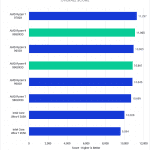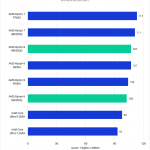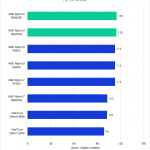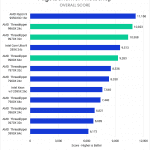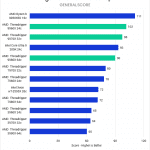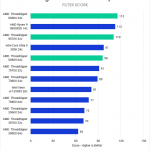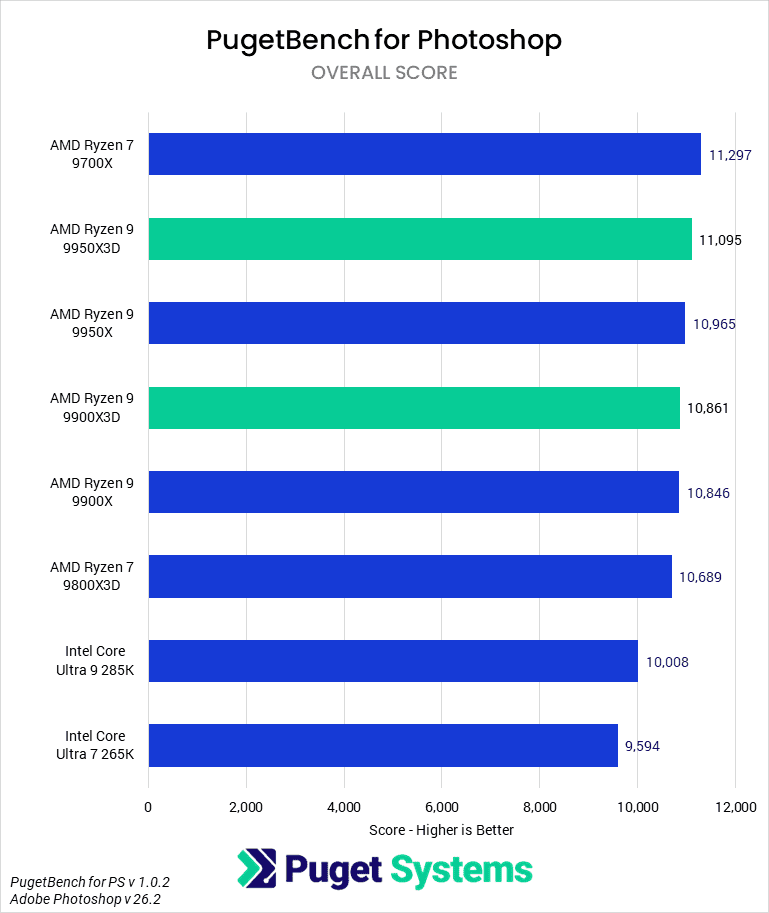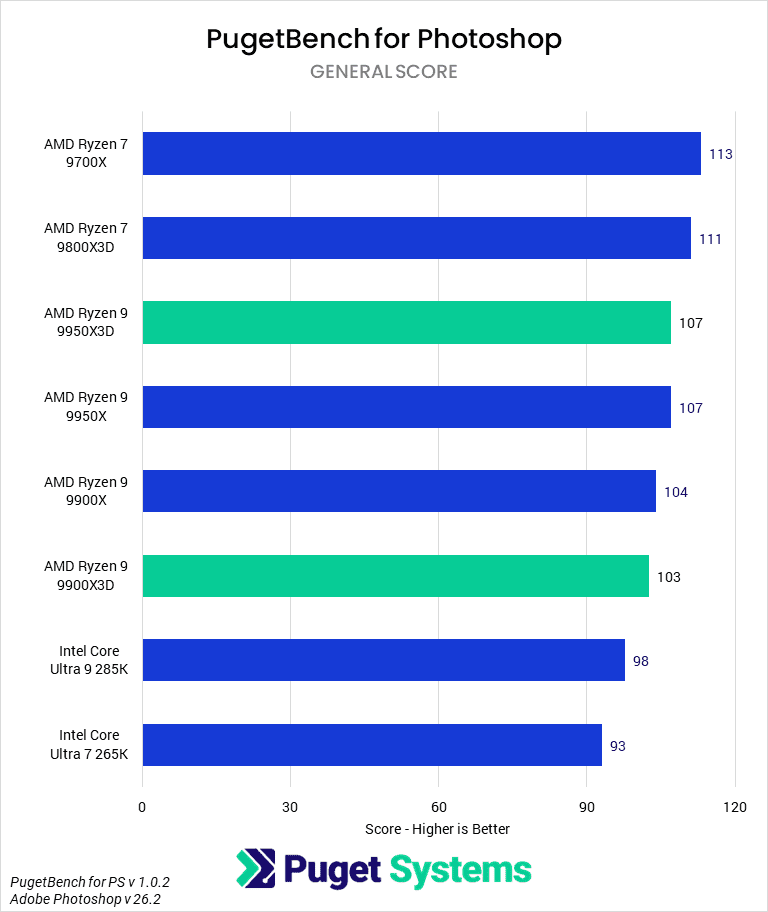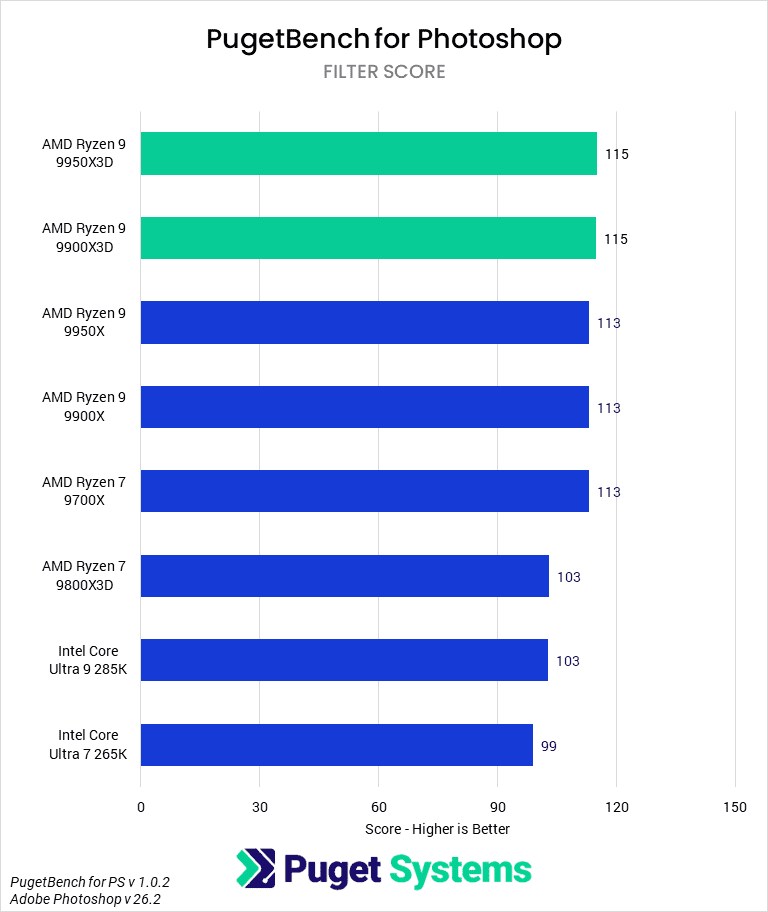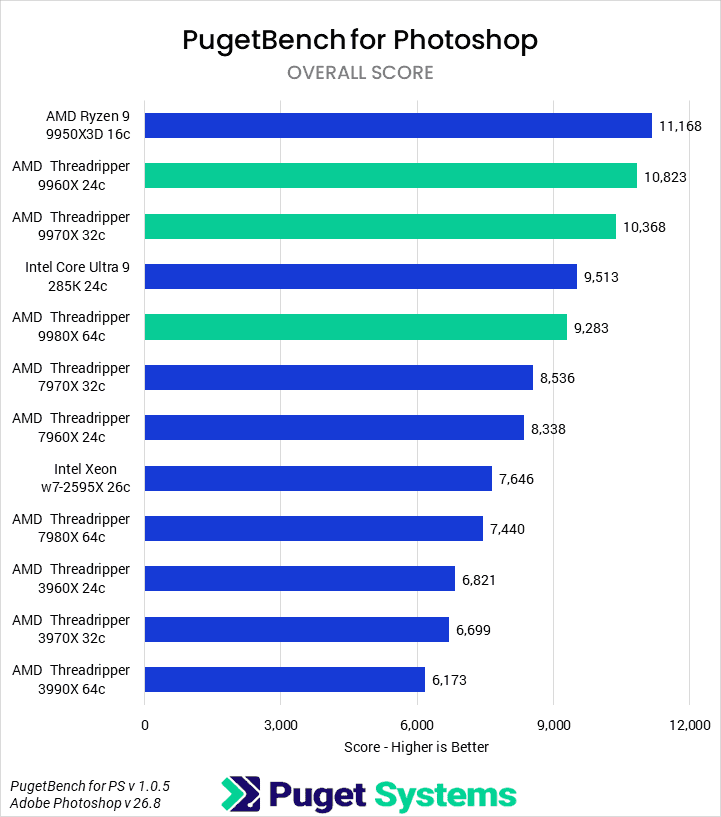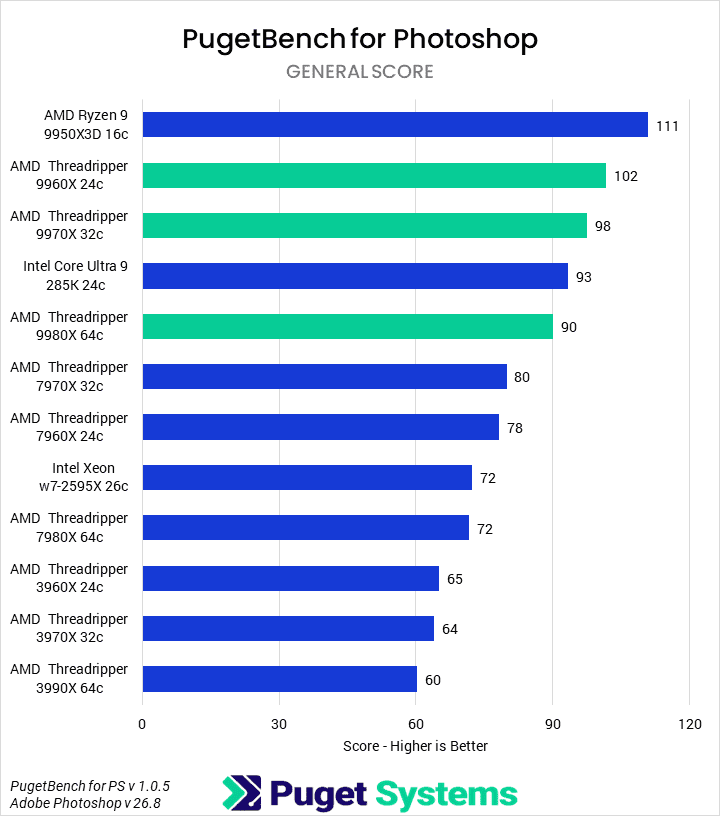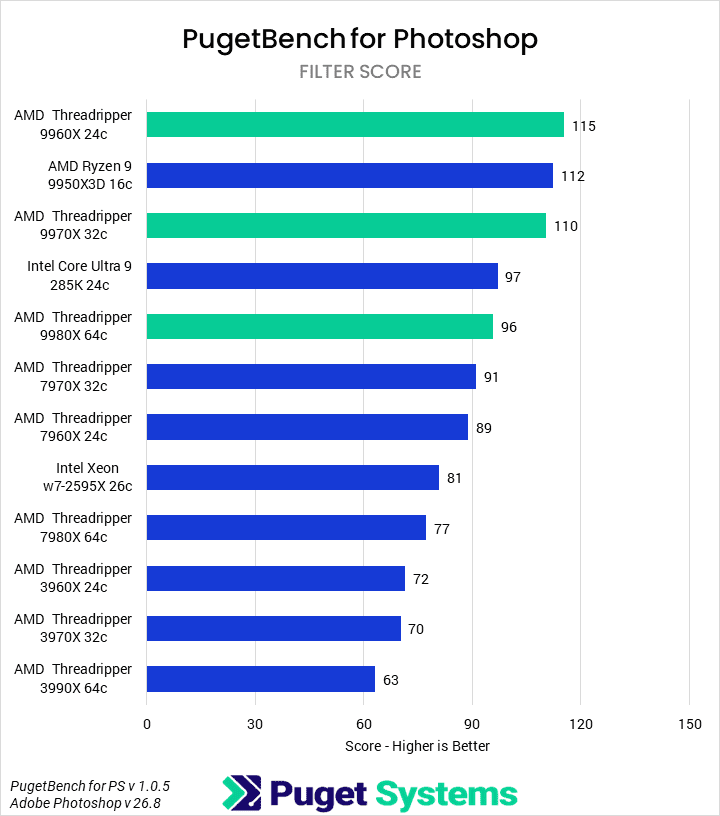
Hardware Recommendations for Adobe Photoshop
Our Adobe Photoshop benchmark and articles provide performance data across numerous processor platforms to bring you reliable hardware recommendations.
Puget Labs Certified
These hardware configurations have been developed and verified through frequent testing by our Labs team. Click here for more details.
Photoshop System Requirements and Benchmarks
Quickly Jump To: Processor (CPU) • Video Card (GPU) • Memory (RAM) • Storage (Drives) • FAQ
Like most software developers, Adobe maintains a list of system requirements for Photoshop that can be used to help ensure the hardware in your computer system will work with their software. However, most “system requirements” lists tend to cover only the very basics of what hardware is needed to run the software, not what hardware will actually give the best performance. In addition, sometimes these lists can be outdated, show old hardware revisions, or simply contain sub-optimal hardware.
Because of how inconsistent these lists can be, here at Puget Systems we run and publish our own set of extensive hardware benchmarks to ensure that the systems we sell are perfectly tailored for Photoshop. Even better, you don’t have to take our word for what to buy, you can browse and examine all our testing in detail in our Photoshop hardware articles. Based on all our testing, we have our own list of recommended hardware for an Adobe Photoshop PC.
Processor (CPU)
The processor (or CPU) is one of the most important pieces of a Photoshop workstation. While GPU acceleration is gaining traction, right now your choice of CPU is usually going to make a much larger impact on overall system performance. However, be aware a CPU that is theoretically more powerful is not always better since there is a limit to the number of cores that Photoshop can effectively take advantage of. In many cases, spending more money can actually result in worse performance so it is more important to get the right CPU over a more expensive one.
What CPU is best for Photoshop?
Currently, the best CPU for Photoshop is AMD’s Ryzen™ 7 9700X. It leads the pack of other Ryzen™ 9000 and Intel Core™ Ultra processors in our Photoshop benchmark, even scoring above the higher core count options within the same generation. If you need to use an Intel chip instead, the Core™ Ultra 9 285K is their best option – but it is about 15% slower in Photoshop while also being more expensive.
Full results available in our article:
AMD Ryzen 9 9950X3D and 9900X3D Content Creation Review
Do more cores make Photoshop faster?
Adobe has been making improvements in order to make more effective use of higher core count CPUs, but for now, having beyond ~8 cores is only going to give you a minimal increase in performance. In general, the architecture of the CPU is often more important than the raw number of cores.
Does Photoshop work better with Intel or AMD CPUs?
At the moment, AMD has a slight lead over Intel. This can change as both brands release new products, however.
Does Photoshop perform well with a Dual Xeon or EPYC CPU setup?
Since Photoshop cannot effectively utilize higher core counts, workstations with two physical CPUs tend to do relatively poorly. Not only is there additional overhead when there are multiple CPUs in the system, these CPUs also tend to be clocked lower than their single CPU counterparts which results in even lower performance.
Recent Photoshop CPU Articles:
Video Card (GPU)
Adobe has been increasing support for GPU acceleration in Photoshop over the last few years, but currently there are only a handful of effects that can utilize the video card. Adobe maintains a list of effects that are GPU accelerated in their GPU FAQ: Photoshop GPU card FAQ
Although Adobe is constantly expanding GPU acceleration support to Photoshop, the current demand on the video card is actually relatively light. Even an entry video card will be able to provide a huge boost in performance for GPU-accelerated effects but there is a sharp drop in performance benefit by using anything more than a mid-range video card. A few tasks may be able to see a performance benefit to using a high-end card like the GeForce RTX 5090, but an RTX 5070 is going to get you within a few percent of the best performance possible.
What GPU (video card) is best for Photoshop?
For Photoshop, it is extremely important to have a supported GPU, but the actual performance of that card will not make a major impact on performance. Compared to the high-end GeForce RTX 5090, the much more modest RTX 5070 is within a single percent – even when only looking at GPU-accelerated tasks – and the 4060 Ti is only a couple percent back. These results are so close that any of the GeForce RTX 30, 40, or 50 Series cards should be plenty fast enough… so much so, in fact, that we don’t really do in-depth GPU testing on Photoshop very often anymore.
If you want to dig further into GPU performance in Photoshop, we have a new public results comparison tool for PugetBench that can help.
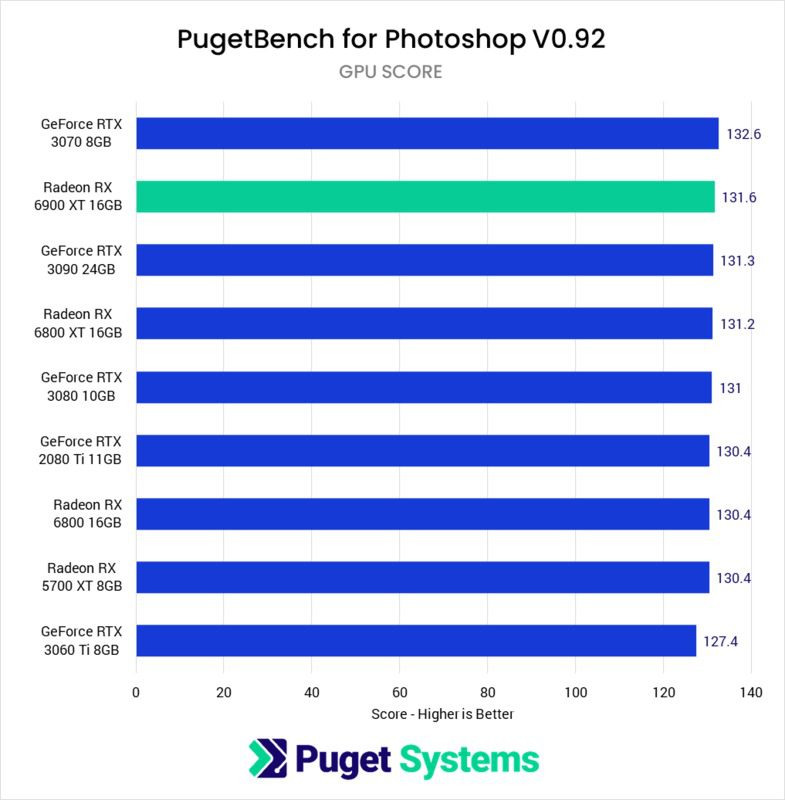
Adobe Photoshop – AMD Radeon RX 6900 XT Performance
Is onboard graphics good enough for Photoshop?
Photoshop can run with onboard graphics, but be aware that even a low-end GPU will be nearly twice as fast for GPU-accelerated tasks. In addition, most onboard graphics can only use 512-1024MB of memory which is adequate for a single 1080p display, but if you have a 4K display or multiple displays, we highly recommend using a dedicated graphics card.
How much VRAM (video card memory) does Photoshop need?
While a higher-end GPU may not give significantly higher raw performance, it is essential that your video card has enough VRAM or video card memory for your projects. However, unless you have multiple 4K displays, even 4GB of VRAM should be plenty. Since all the video cards we currently offer for Photoshop have at least 8GB of VRAM, this should not be a concern for most users.
Does Photoshop need an RTX PRO video card?
Photoshop works great with a professional-grade card, formerly named Quadro, but since 10-bit display support was added for GeForce in late July 2019, the main advantage of the newer RTX PRO™ cards is additional VRAM on the high-end models and slightly higher reliability.
Does Photoshop run better with NVIDIA or AMD?
At the moment, NVIDIA has the lead over AMD in terms of performance. We have also found that NVIDIA cards tend to be slightly more reliable (both from a hardware and driver standpoint), which is why we typically use NVIDIA over AMD unless there is a clear benefit to using an AMD card.
Recent Photoshop GPU Articles:
Memory (RAM)
While the exact amount of RAM you need is going to depend on the size and number of images you will be working with, we generally recommend a minimum of 16GB for all our systems. Memory usage in Photoshop can quickly shoot up, however, so it is important that you ensure you have enough system RAM available.
How much RAM does Photoshop need?
The exact amount you need will depend on exactly what you are doing, but based on your document size we recommend a minimum of 16GB of RAM for 500MB documents or smaller, 32GB for 500MB-1GB, and 64GB+ for even larger documents.
Note that this is for the document size once opened (as found in the “Document Sizes” section of the Info Panel or status bar), not the file size of the file itself. Photoshop will often list two sizes such as 20.3M/60.2M. The left number is the flat file size (if you were to export without compression), while the right number is the actual size of the Photoshop document with all the layers. The right number which includes all the layers is typically the most relevant when deciding how much RAM your system needs.
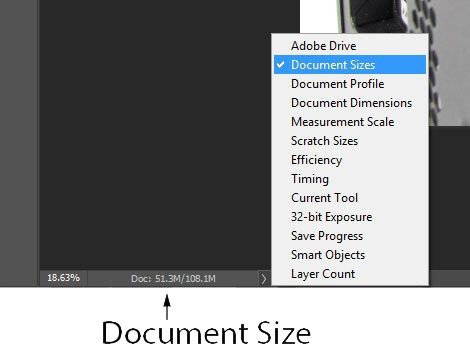
Recent Photoshop Memory Articles:
Storage (Hard Drives)
Photoshop may not be the most storage-heavy application out there, but it is still important to have fast and reliable storage to keep up with the rest of your system.
What type of storage drive should I use for Photoshop?
There are three main types of drives you might use for a Photoshop workstation: SSD, NVMe, and the traditional platter drive. Of these three, traditional platter drives are the slowest but are extremely affordable and available in much larger capacities than SSD or NVMe drives. Due to this, they make excellent long-term storage drives, but depending on the size and resolution of your assets, they may not ideal to work directly off of.
SATA SSDs are several times faster than a platter drive but are also more expensive. These drives are excellent for a wide range of tasks such as holding your OS and applications and storing projects you are actively working on.
NVMe drives come in two flavors (M.2 and U.2), but either one will be significantly faster than even an SSD drive. They can be more expensive than a SATA SSD, but in return can be up to twelve times faster! In most cases, you will not see much of a performance increase with an NVMe drive since a modern standard SSD is already fast enough that it is rarely a performance bottleneck, but as the cost of these drives continue to fall, they can be used as an OS and application drive to make your system boot and launch programs a bit faster.
What storage configuration works best in Photoshop?
While you could get by with just a single drive, we recommend at least a two drive configuration depending on your budget and desired performance level:
- Primary Drive – OS/Software (SSD/NVMe) – Includes your operating system and the base Photoshop installation. An SSD is highly recommended as it will greatly improve how fast the OS and programs startup, but you can also upgrade to a faster NVMe drive for a small performance benefit.
- Secondary Drive – Project Files (Platter/SSD/M.2 NVMe) – If possible, it is a good idea to keep your photos and catalogs on a secondary drive. For most users even a platter drive should be more than fast enough, although a SSD tends to be snappier and will often smooth out your workflow.
- Optional Tertiary Drive – Scratch Drive (SSD/M.2 NVMe) – Most of the time, having your scratch files on your primary SSD should be just fine, but if your work involves heavy use of the scratch space, it may be beneficial to have a dedicated drive just for those files.
Can you work with Photoshop files directly from an external drive?
Technically, you could keep your projects on an external drive and work directly from that drive. However, this is one of the most common causes of performance and stability issues we hear about from our customers. We highly recommend copying all your files to a local drive before working on them. External drives are terrific for backup and archiving, but not ideal to work off of.
That analysis changes if you are looking at high-performance network-attached storage, rather than just a basic external hard drive. A serious software-defined storage system, especially one utilizing exclusively flash-based drives (rather than spinning disk drives), can absolutely be fast enough to edit directly from! We offer those types of solutions, both in the form of our Puget Storage line of servers as well as more bespoke options for high-end installations. This approach also facilitates easy sharing between various users in a studio and provides redundancy in case of a drive failure. It is important to make sure your network infrastructure is up to the challenge too!
Frequently Asked Questions
I’m thinking of moving from Mac to PC. Can you help?
Absolutely! Over the years we have helped quite a few of our customer make the move from Mac to PC. In fact, it is a large enough number that we have a dedicated Need help moving from Mac to PC? page to answer some of the more common questions we receive.
Are there any AI-powered features in Photoshop?
Yes – Adobe has been building several AI-based features across various Creative Cloud applications, including Photoshop. They are collectively branded as “Adobe Sensei“. Within Photoshop, many of these center around automated detection of parts of an image – like Select Subject, Object Section Tool, and Auto Selection. Probably the most well-known AI feature in Photoshop is Content Aware Fill, which can feel almost magical when you first see it in action. There is an even more advanced version called Generative Fill which is in development and uses Adobe Firefly cloud-based AI.
Do any Puget Systems computers support Thunderbolt?
Yes! Our Photoshop workstation shown above does not have Thunderbolt, but we have other system options which do offer Thunderbolt 4 capability. Please contact our consultants to discuss which of our systems would best meet your needs for both Photoshop performance and connectivity, or take a look at our custom configure page and check out which platforms list Thunderbolt support.
Do Puget Systems support 10-bit displays?
Yes, all our Photoshop workstations do support 10-bit displays! In the past, you needed to use an NVIDIA Quadro video card or a Blackmagic Decklink card to enable 10-bit support, but as of July 29th, the GeForce “Studio Driver” also supports 10-bit displays. Note that you also need to enable support in Photoshop for it to function.
How much faster will a new workstation be for Photoshop?
If you want to know exactly how much faster one of our Photoshop workstations would be over your current system, we recommend downloading our Puget Systems Photoshop Benchmark. This benchmark is what we use in all our internal testing which means the score you get can be directly compared against those in our Hardware Recommendation section or in our various hardware analysis articles.
I have a ton of storage drives. Do you have anything with more room?
We can certainly configure a more workstation with a larger drive capacity if that is what you need, though in many cases external storage may be a better option. Please contact our consultants to discuss your specific needs and the various options we have to meet them.
I’m not sure what system hardware I should use for Photoshop. Help!
Depending on how much you want to dig into hardware and system specs, we have a couple different ways to help. First, we have a Hardware Recommendations page specifically for Photoshop that goes over all the different major hardware components and why you would use one part over another. Alternatively, you can always contact one of our consultants and we can help you configure a system that is perfectly tailored for your workflow.
